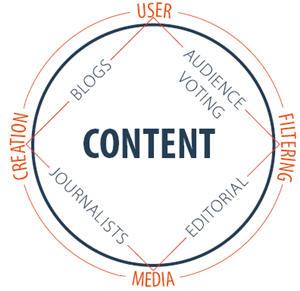Better ways to help readers filter and edit the news
 Back in our Future of Media Framework we showed some of the dynamics in content creation, as in the image on the left, where both users and traditional media were engaged in creating and filtering content. User content creation, in the form of blogging, micro-blogging, sharing on social networks and more, has of course surged exponentially.
Back in our Future of Media Framework we showed some of the dynamics in content creation, as in the image on the left, where both users and traditional media were engaged in creating and filtering content. User content creation, in the form of blogging, micro-blogging, sharing on social networks and more, has of course surged exponentially.
User filtered content, which I’ve talked about for many years now as an alternative to human editors, has recently progressed primarily through tools that aggregate the links shared on Twitter, such as Tweetmeme and Topsy. This is because Twitter (and Facebook, though the data is not readily available to third-parties to use) has become the dominant platform in how people share links and content of interest.
These Twitter-based content filters are very crude, not least having no good way of sorting by interest profile. As such they are filled with the trivial rather than what would be interesting to any one person.
Into this world the New York Times reports that Yahoo! is using search queries to guide its news coverage. Later today it will launch Upshot, a news blog that will select stories on US affairs, politics, and media based partly on what search queries are prominent at that time, reflecting what people want to know.
In the article the Yahoo! editor makes a big show of saying that human editors will be making the decisions, and that this system will just provide input to that process. Indeed, many publishers have found that the sweet spot is in combining algorithm-based filtering with human judgment.
What is most interesting here is the new source of discovering what people are interested in. Search is done by far more people than posting links on Twitter. Yet I am sure there continue to be vast untapped fields in how we can tap what people are discovering, thinking, or wondering to filter the news effectively.
